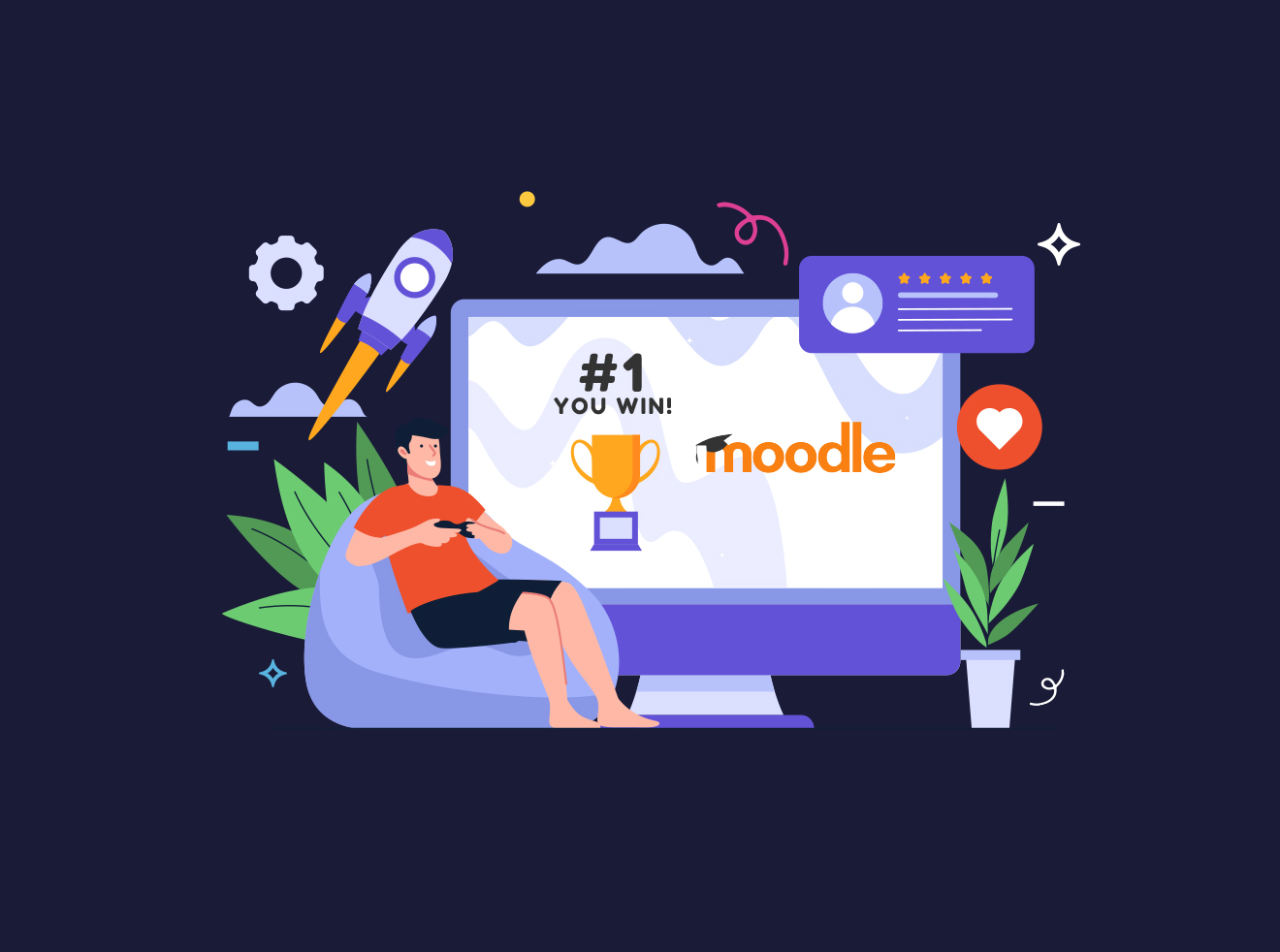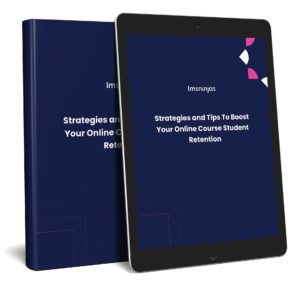How does user experience impact the LMS web design process?
As e-learning and remote work became more popular, the use of LMS websites increased among organizations, schools, and individuals looking for digital learning solutions. This rapid development highlights the importance of well-designed user experiences for LMS platforms in order to provide efficient online learning.
User experience, or UX, is how people use and think about a product or system. UX design for LMS websites includes creating simple interfaces supporting content consumption and engagement.
An appealing UX establishes all additional LMS features and operations. The quality of the user interface (UX) is the deciding factor in whether or not a site visitor will return.
This article focuses on the important role UX plays in LMS web design and how it should be considered in platform interfaces, content presentation, and functionality that engage learners.
Understanding LMS Web Design

LMS platforms provide unified online access to training sessions, courses, and learning resources. Recent years have seen a change in education brought on by the explosive rise of e-learning and the urgent requirement of a well-designed LMS website.
The approach to learning and training that we take has changed as a result of these Learning Management System (LMS) websites. They provide accessible, dynamic digital learning environments, which act as the foundation of this transition.
These platforms break down geographical constraints, making it remarkably simple and flexible for organizations, schools, and individuals to access instructional content and professional development.
A few of the primary uses for learning management systems are as follows: content distribution, assessment administration, progress tracking, social collaboration, and learner analytics. Using a learning management system (LMS), instructors and institutions can design their own online courses, collaborate on syllabuses, monitor student progress, and facilitate learner engagement.
The importance of LMS websites and their layout goes beyond merely being practical. LMS websites have developed into crucial elements in conventional learning environments and business training programs.
They provide advanced learner involvement in addition to content delivery and assessment. Their design, which redefines the educational experience, is at the center of this shift. The dissemination of knowledge, development of skills, and creation of a friendly atmosphere for students, educators, and administrators all depend on effective LMS website design.
LMS Web Design Guidelines
A high-quality LMS website design offers many advantages, including:
- Enhanced learner engagement via interactive interfaces
- Personalized learning routes personalized to individual students
- Learning on any device, from anywhere
- Simplified course management and content updates
However, there are obstacles to overcome on the path to realizing the full potential of LMS websites and their design. It takes skill to create an LMS that achieves the ideal harmony between education and technology.
The following are some difficulties in creating seamless LMS experiences:
- Difficult navigating via various course materials
- Keeping the platform flexible with multimedia material
- Balancing features for instructors and students
- Ensuring device accessibility
Addressing these LMS website design challenges requires strategic user experience (UX) design.
A well-designed LMS website needs to be both technologically and professionally solid. This is mostly achieved with the help of LMS experts. An LMS website is an environment that empowers, engages, and supports students, teachers, and administrators. Modern, efficient teaching depends on a precise blending of technology and learning theory.
The Essential Role of User Experience (UX)

User Experience (UX) is the compass that guides learners on their educational journey when it comes to Learning Management System (LMS) website design. The complete experience of users, when they engage with the LMS platform, is encompassed by UX. It’s about making every click, scroll, and interaction intuitive, meaningful, and, most importantly, productive.
UX includes the user interface, visual design, content presentation, feature set, and task flow. Users who experience a positive user experience remain interested and become devoted users. UX in LMS website design entails building a learning environment that is efficient, interesting, and effective by designing with the end-user in mind. If you want students to use your learning management system (LMS), focus on the UX of the platform.
The impact of good UX in LMS design extends well beyond appearances. It has a significant impact on both learning outcomes and the general effectiveness of educational initiatives. Here are some significant ways that effective UX improves the educational experience:
Smart Navigation: Learners can easily find information with the help of an LMS that has well-organized menus and simple navigation. Navigation that is simple is less frustrating and promotes exploration.
Engagement and Drive: Engaging UX components encourage students to stay on task and finish courses, such as gamification, interactive quizzes, and progress tracking.
Accessibility: An inclusive layout makes sure that all users, regardless of disability, can access content. Features like screen readers, subtitles, and flexible interfaces are all part of good UX.
Personalization: Individual preferences are taken into account when designing customizable dashboards and content recommendations, which maximizes engagement.
UX design is required for LMS websites in order to:
- Present complex information in simple formats.
- Convert complex workflows into simple step-by-step processes.
- Use intuitive navigation to swiftly get users to the relevant information.
- Create visually appealing and motivating layouts.
For instance, Instead of displaying all content at once, an online course platform could employ progressive disclosure to reveal courses gradually. This improves the learner’s focus and sense of progress.
Here are some more ideas for good UX in LMS:
Clear Dashboard: The LMS dashboard ought to provide a concise summary of the courses, an overview of the work, and the deadlines. Labels and icons should be self-explanatory.
Responsive Design: Ensure that the LMS is accessible on a variety of platforms, including computers and smartphones. The content should scale to fit different screen sizes.
User-Friendly Content Creation: LMS should provide educators with simple authoring tools that allow them to generate interesting content without requiring technical knowledge.
Feedback Mechanisms: Use feedback forms and surveys to collect user feedback and ensure continuous improvement.
Tracking Progress: Users should be able to quickly and easily keep track of their progress, including completed modules, grades, and impending tasks.
Discussion Forums: Use discussion forums to encourage interaction and collaboration among learners.
Continuous UX research and testing are essential for the continued development of LMS interfaces. LMS platforms can engage diverse learners by implementing proven UX principles.
User experience is a crucial component of an efficient LMS website design, not just a feature. Positive learning experiences increase the likelihood that students will engage with the material, finish their courses, and succeed academically. Improved learning outcomes and, ultimately, the success of education and training programs are both impacted by good UX.
LMS Web Design Principles and Guidelines
Adherence to basic concepts and criteria is a key component of building an environment that really places users at the center of its design in the dynamic world of Learning Management System (LMS) design.
Creating the best interface and user flow necessitates putting the target users at the center of the design process. LMS interfaces should be simple, consistent, and targeted to specific tasks such as enrolling in classes, submitting assignments, tracking progress, and consuming learning resources. In this section, we will look more closely at these fundamental features of LMS interface design.
LMS User Interface Design
User-Centered Approach
When it comes to Learning Management System (LMS) design, putting the user first is essential. Understanding the different demands of learners, educators, and administrators requires in-depth user research, surveys, interviews, and user testing, as well as incorporating their feedback into the design process on a continuous basis to improve the user experience.
Intuitive Navigation
Using the LMS should be simple. Clear, self-explanatory labeling free of complexity enables users to navigate the LMS autonomously, making it simple to find information and functionality without additional instruction.
Information Hierarchy
Effective content organization requires a coherent information hierarchy. A strong visual hierarchy of headers, subheadings, and typography directs users through the material, ensuring that important information stands out while retaining overall clarity.
Layout Consistency
Consistency in layout and design components creates trust and familiarity. The reliability of the user experience is enhanced by the use of consistent color schemes, fonts, button styles, and the placement of buttons and functionalities.
Personalization
It’s important to acknowledge and respect the individual’s preferences. Allowing learners to personalize their dashboards, create learning goals, and choose content based on their interests boosts engagement while protecting user privacy.
Accessibility
Diversity is an important design consideration. Implementing accessibility features like screen readers, subtitles, alt text for images, and flexible interfaces ensures all users have equal access.
Mobile-First Design
Given the predominance of mobile devices, a mobile-first design approach is necessary for smooth accessibility across several screen sizes. Compatibility is ensured via responsive design and extensive cross-platform testing.
Usability Testing
Maintaining a user-friendly LMS requires regular usability testing. Participating in usability testing with representative users at various phases of development provides vital feedback for continued improvement.
Iterative Design
Creating an LMS is a continuing, iterative process. Adopting a design, testing, user input, and refinement cycle ensures that the LMS remains flexible and responsive to changing user needs and educational landscapes.
Content Presentation and Organization
The way in which LMS platforms organize and present instructional content has an impact on how it’s used. Course content should be organized in logical learning progressions with distinct navigational paths. Creating an immersive and successful learning experience requires optimizing how educational content is presented and structured within a Learning Management System (LMS).
The first step in effective content organization is to organize linked classes and materials into simple modules or units. To chunk information, each module focuses on certain subtopics.
User experience (UX) should be considered when designing courses. This starts with logical structuring, which ensures that the content flows smoothly and is aligned with the learning objectives. Each course should have a clear and interesting narrative that brings students through an educational journey that is seamless.
Content Hierarchy and Structure
The art of visual hierarchy involves giving the content a higher priority using design components like fonts, colors, and spacing. It guides the learner’s attention to the most important aspects of the course in an LMS. A clearly established information architecture ensures that content is appropriately categorized, making it simple for users to find what they need.
Content hierarchy and formatting establish linkages within modules. Headings, brief paragraphs, and bullet points make it easier to read quickly. Key ideas can be highlighted with bold and colored text. Icons graphically mark distinct forms of information, such as assignments or debates.
Predictability is enhanced by consistency in how content is delivered. All course materials, including headings, subheadings, and navigation, should follow a consistent format. This consistency decreases cognitive strain and allows students to focus on the subject matter.
Elements such as navigation bars, menus, and buttons are aligned with a consistent pattern. This builds familiarity, so learners know where to look for elements. Designs that are simple and clean lessen cognitive stress.
Provide downloadable documents and transcripts together with audio and video for multimedia content. Image file sizes that have been optimized reduce load times.
Responsive designs detect smaller mobile devices and reorganize material to improve readability. The structuring of content immediately facilitates or inhibits the learning experience. Using UX principles promotes efficient consumption.
Educators can design a learning environment that encourages engagement and knowledge retention by carefully planning and presenting information within the LMS. In order to create a superior user experience, it is important to adhere to the principles of logical course organization, emphasis on visual hierarchy, and consistency of content.
Improving LMS Website Usability and Accessibility
It is essential to ensure that a Learning Management System (LMS) is both user-friendly and accessible to a diverse audience. Usability and accessibility are critical components of the LMS user experience. Students must be able to navigate websites and access content properly.
Communication must be clear and concise. Language should be simple, free of jargon, and logically structured. Effective communication is especially important in educational settings because clarity improves the learning process.
Plain language guidelines should be followed when creating platform content. Short, scannable paragraphs and lists boost online readability. Content is optimized for search engines by using descriptive headings and meta-descriptions.
Given the widespread use of mobile devices, a mobile-first approach guarantees that the LMS is accessible on a variety of screen sizes. Layouts must be compatible with smartphones and tablets.
Flexible grids, scaled text, and buttons rearrange content on smaller screens. The user experience is responsively designed to adapt to multiple devices, delivering a consistent user experience.
The importance of accessibility cannot be overstated. LMS content must adhere to online accessibility standards and guidelines to be used by people with disabilities. Screen readers, subtitles, and flexible interfaces are crucial features.
Usability testing with the target user group must be conducted often. Gathering input from users and observing their interactions with the LMS exposes areas that may need improvement, hence improving the system’s overall usability.
Increasing the usability and accessibility of LMSs for various learners improves the entire LMS user experience. Users can concentrate on learning rather than navigating sites.
Challenges in UX LMS Web Design
There are challenges along the way to achieving the best learning management system (LMS) user experience (UX). Here, we explore the typical challenges faced during LMS UX design and provide workable solutions and best practices to get past them.
Integration Difficulty
LMS platforms frequently require the integration of a wide range of tools, third-party apps, and content types. It might be difficult to ensure that these aspects mix seamlessly into a unified and user-friendly experience.
Solution: Invest in LMS solutions that place a premium on robust integration and interoperability. Choose tools with user-friendly interfaces and that allow for smooth data flow between the LMS and external applications. Prioritize systems that implement widely established data interchange standards, hence simplifying integration operations.
Scalability issues
Keeping a consistent performance level as an LMS’s user base expands becomes a challenging commitment. It is a continuous concern to ensure that the system can accommodate rising user loads without compromising its functionality.
Solution: Select LMS solutions that are built for scalability. These platforms should be able to accommodate increasing user numbers while retaining good performance. Assess server capacity on a regular basis and be prepared to expand infrastructure to handle a greater user base without interruption.
Content Management
Managing a large repository of educational content involves organizational, updating, and version control issues. Keeping content accessible and up to date can be a substantial effort.
Solution: Integrate content management systems (CMS) into the LMS to improve content organization, version control, and metadata management. WordPress-based sites can be a great option in this regard.
Use robust search options to help users rapidly find the content they require. Review information on a regular basis to guarantee its accuracy and relevancy.
User Training
Complex LMS interfaces and functionality may overwhelm users, especially educators and learners. This might cause dissatisfaction and impede platform adoption.
Solution: Provide extensive training and support tools to help users navigate the LMS. Provide user-friendly manuals, tutorial videos, and a responsive help desk to respond to user concerns and difficulties as soon as possible. Make user training a priority during the onboarding process to boost user confidence and competency.
Data Security
Protecting sensitive user data is critical, especially in educational contexts where student information must be kept secure.
Solution: Implement strong data security procedures within the LMS. Encrypt data while it is in transit and at rest. To detect and minimize potential threats, conduct frequent security audits and vulnerability assessments. Ensure compliance with data protection standards, taking into mind your region’s specific data privacy legislation.
Customization Balance
Finding the correct balance between LMS customization and maintainability is a continuous concern. Over-customization might cause technological complications and jeopardize system stability.
Solution: Prioritize customization choices that correspond to your user base’s individual demands and preferences. Ensure that bespoke alterations are long-lasting and do not jeopardize system stability. Conduct careful testing following any customization to ensure that no new issues are introduced.
Educators and administrators can more effectively manage the complexities of LMS UX design by addressing these difficulties with practical solutions and best practices. These approaches enable schools to establish a unified and user-centered learning environment that benefits both students and teachers.
LMS Web Design
Modern LMS platforms that want to deliver engaging, successful online learning must have a well-designed user experience. LMS websites can offer seamless experiences optimized for all types of users and their different demands by incorporating UX ideas and practices throughout the design process.
While there are challenges, ongoing study, testing, and improvement centered on learners will evolve LMS interfaces over time.
Are you ready to begin on an LMS optimization journey? Our LMS website development and design services place a premium on user experience, providing a smooth learning process. Let us reshape education in the digital age.




